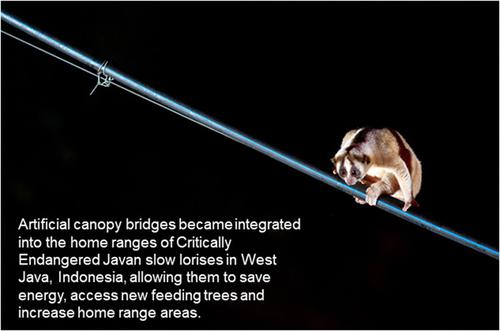当前位置:
X-MOL 学术
›
Am. J. Primatol.
›
论文详情
Our official English website, www.x-mol.net, welcomes your feedback! (Note: you will need to create a separate account there.)
Artificial canopy bridges improve connectivity in fragmented landscapes: The case of Javan slow lorises in an agroforest environment.
American Journal of Primatology ( IF 2.4 ) Pub Date : 2019-12-05 , DOI: 10.1002/ajp.23076 Hélène Birot 1 , Marco Campera 1, 2 , Muhammad Ali Imron 3 , K A I Nekaris 1, 2
American Journal of Primatology ( IF 2.4 ) Pub Date : 2019-12-05 , DOI: 10.1002/ajp.23076 Hélène Birot 1 , Marco Campera 1, 2 , Muhammad Ali Imron 3 , K A I Nekaris 1, 2
Affiliation

|
Canopy bridges are increasingly used to reduce fragmentation in tropical habitats yet monitoring of their impact on the behavior of primates remains limited. The Javan slow loris (Nycticebus javanicus) is endemic to Java, Indonesia, where the species most often occurs in human-dominated, highly patchy landscapes. Slow lorises cannot leap, are highly arboreally adapted, and are vulnerable on the ground. To increase arboreal connectivity, as part of a long-term conservation project in Cipaganti, West Java, we built and monitored seven slow lorises bridges of two types-waterline or rubber-and monitored their use by seven adult individuals from 2016 to 2017. Motion triggered camera traps collected data for 195 ± standard deviation (SD) 85 days on each bridge. We collected 341.76 hr (179.67 hr before and 162.09 hr after the installation of bridges) of behavioral and home range data via instantaneous sampling every 5 min, and terrestrial behavior (distance and duration of time spent on the ground) via all occurrences sampling. We found that slow lorises used bridges on average 12.9 ± SD 9.7 days after their installment mainly for traveling. Slow lorises showed a trend toward an increase in their home range size (2.57 ha before, 4.11 ha after; p = 0.063) and reduced ground use (5.98 s/hr before, 0.43 s/hr; p = 0.063) after implementation of bridges. Although the number of feeding trees did not change, new feeding trees were included in the home range, and the proportion of data points spent traveling and exploring significantly decreased (p = 0.018). Waterline bridges serve a purpose to irrigate the crops of local farmers who thus help to maintain the bridges, and also ascribe value to the presence of slow lorises. Other endemic mammal species also used the bridges. We advocate the use and monitoring of artificial canopy bridges as an important supplement for habitat connectivity in conservation interventions.
中文翻译:

人工天篷桥改善了零散景观的连通性:以农林环境中的爪哇慢弯猴为例。
冠层桥越来越多地用于减少热带栖息地的碎片化,但是对其对灵长类动物行为的影响的监测仍然有限。爪哇慢懒猴(Nycticebus javanicus)是印度尼西亚爪哇的特有种,那里的物种最常见于人类占主导的高度斑驳的地貌。慢的懒猴不能跳跃,高度适应树木,并且在地面上很脆弱。为了增加树木的连通性,作为西爪哇省Cipaganti一项长期保护项目的一部分,我们在2016年至2017年间建造和监视了两种类型(水线或橡胶)的七条慢梯桥梁,并监视了七位成年个体的使用。触发的相机会在每座桥梁上收集195±标准偏差(SD)85天的数据。我们收集了341.76小时(之前的179.67小时和162。每隔5分钟进行一次瞬时采样,获得行为和家庭范围数据;在桥梁安装之后的9小时内;通过所有事件采样,获得地面行为(距离和在地面上停留的时间)。我们发现,慢速鹦鹉螺在安装后平均每天使用12.9±SD 9.7天,主要用于旅行。慢懒猴在实施桥梁后显示出其家园范围增大的趋势(之前为2.57公顷,之后为4.11公顷; p = 0.063),减少了土地使用(之前为5.98 s / hr,之前为0.43 s / hr; p = 0.063) 。尽管采食树的数量没有变化,但新的采食树被包括在家庭范围内,花在旅行和探索上的数据点所占的比例显着下降(p = 0.018)。水线桥梁的目的是灌溉当地农民的作物,从而有助于维护桥梁,也将慢速虫害的存在归因于价值。其他地方性哺乳动物物种也使用了桥梁。我们提倡使用和监测人工林冠桥作为保护干预措施中栖息地连通性的重要补充。
更新日期:2020-04-13
中文翻译:

人工天篷桥改善了零散景观的连通性:以农林环境中的爪哇慢弯猴为例。
冠层桥越来越多地用于减少热带栖息地的碎片化,但是对其对灵长类动物行为的影响的监测仍然有限。爪哇慢懒猴(Nycticebus javanicus)是印度尼西亚爪哇的特有种,那里的物种最常见于人类占主导的高度斑驳的地貌。慢的懒猴不能跳跃,高度适应树木,并且在地面上很脆弱。为了增加树木的连通性,作为西爪哇省Cipaganti一项长期保护项目的一部分,我们在2016年至2017年间建造和监视了两种类型(水线或橡胶)的七条慢梯桥梁,并监视了七位成年个体的使用。触发的相机会在每座桥梁上收集195±标准偏差(SD)85天的数据。我们收集了341.76小时(之前的179.67小时和162。每隔5分钟进行一次瞬时采样,获得行为和家庭范围数据;在桥梁安装之后的9小时内;通过所有事件采样,获得地面行为(距离和在地面上停留的时间)。我们发现,慢速鹦鹉螺在安装后平均每天使用12.9±SD 9.7天,主要用于旅行。慢懒猴在实施桥梁后显示出其家园范围增大的趋势(之前为2.57公顷,之后为4.11公顷; p = 0.063),减少了土地使用(之前为5.98 s / hr,之前为0.43 s / hr; p = 0.063) 。尽管采食树的数量没有变化,但新的采食树被包括在家庭范围内,花在旅行和探索上的数据点所占的比例显着下降(p = 0.018)。水线桥梁的目的是灌溉当地农民的作物,从而有助于维护桥梁,也将慢速虫害的存在归因于价值。其他地方性哺乳动物物种也使用了桥梁。我们提倡使用和监测人工林冠桥作为保护干预措施中栖息地连通性的重要补充。



























 京公网安备 11010802027423号
京公网安备 11010802027423号